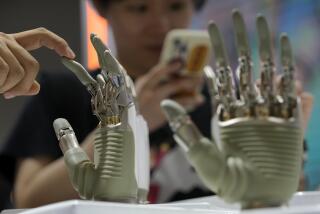Revolution in Manufacturing : Workers Tackle New Job: Rebuilding U.S. Industry
NORTHLAKE, Ill. — For years, as far as Vida Kewin was concerned, working in a factory meant twisting copper wires into cables as they rolled past her, hour after boring hour, on an assembly-line conveyor belt.
No more. Today, at the GTE Communication Systems plant in an industrial suburb west of Chicago, the traditional assembly line, with its repetitive, high-stress, rote application of a single task, is obsolete.
Now Kewin is helping set up a new production center that will begin manufacturing printed circuit boards without the spaghetti of wires that make present-generation boards liable to break down. When that task is complete, she expects to be responsible for four manufacturing functions, including inspection for assembly error.
“When I started here 23 years ago, you did just one job,” Kewin says. “Now you have to do more than one job if you’re going to stay here. That takes more responsibility, but more people feel better about their work. People are more involved in what they are doing.”
Vida Kewin is a foot soldier in America’s new industrial revolution. At plants such as GTE’s Northlake facility, she and her co-workers are showing that U.S. manufacturers can compete with the best that Europe and Japan can offer.
The manufacturing sector has emerged during the last two years as the driving force behind the nation’s continuing economic growth. Industry has restructured at all levels, high-tech as well as traditional heavy machinery, large corporations as well as small. Production techniques common as recently as five years ago are vanishing anachronisms today.
All this has happened thanks to a work force that has learned new skills and adapted to new working conditions. Today’s factory hands typically are at once machinists, quality inspectors and production managers. They work in teams rather than as individuals. They operate with less supervision and, in a break with all the conventions of American industrial management, are expected to interact with management rather than simply take orders.
Not everyone has made the transition.
“People with less schooling and lower levels of skills, if they haven’t got enough seniority to be protected, are going to be losers,” warns Anthony Carnevale, an economist with the American Society for Training and Development in Alexandria, Va. “Many of them are likely to be minorities. And unless we get down to real labor shortages--that means 5% unemployment or less--many of those people are going to be a lost generation.”
Not Room for All
Nor is there room for all, even if all could adapt. Higher productivity is the goal of modernization, and that means more output from fewer workers.
But for the workers who find a niche in the brave new world of manufacturing, the rewards can be great. “The ones that are left are doing a lot of new and more highly paid things,” says John R. Stepp, an associate deputy secretary of labor for labor-management relations.
“It’s a myth that our manufacturing base is eroding and that we are becoming a nation of service providers,” Stepp says. “We’re producing as much as we ever did and the skill level of manufacturing labor has been enhanced. The quality of jobs is higher. Reasoning skills, higher language skills, math and analytic skills are fundamental for the new jobs.”
The Bureau of Labor Statistics projects that jobs with higher skill requirements will continue to expand for the next 12 years. While total employment will grow by 19% by the year 2000, the BLS says, demand for technicians and workers with related skills will expand by 38%.
During the same period, the BLS says, jobs with lower skill requirements will continue to decline. By the year 2000, it predicts, the typical industrial job will be better paid and offer more responsibility and better working conditions than today--but will also require a higher level of education than was the norm only a few years ago.
“Take your average machinist on a production line,” Carnevale says. “He used to be surrounded by people all doing pretty much what he was doing, over and over. The main skills called for (were) eye-hand coordination and the ability to repeat the same operation.
“Now, in these restructured plants, robots and other advanced machinery intervene to do the repetitive work. They can do it more consistently and more accurately. So the worker becomes a machine operator, a production inspector, even a manager.
“He is doing several jobs at once and the skill requirements increase. And these workers have to be trained to integrate a whole range of duties during the course of a production operation. These can be very subtle skills, hard to learn and hard to train.”
GTE’s futuristic plant at Northlake, which makes digital communications switches on the far edge of technology, offers an excellent snapshot of the new American workplace and the evolving hourly American worker. Here, a state-of-the-art product has forced dramatic advances in manufacturing techniques.
Scene Repeated
But what is happening at Northlake is being repeated all over America, in traditional industries as well as high-tech, in big plants and small ones. Consider the case of the 40-year-old plant operated by Caterpillar, one of traditional industry’s giants, in Peoria, Ill.:
Building KK, where Caterpillar manufactures transmissions for huge farm tractors and massive tracked earth-moving machines, is in transition from the traditional assembly line model toward a heavy-equipment version of GTE’s high-tech Northlake facility. As at Northlake, workers from the shop floor are playing an unprecedented role in designing the new operation that they will have to man.
“The hourly guys knew weeks in advance when a new machine was going to be put in and an old one replaced and they had their own ideas about where it should be placed,” says Dan Coyle, the manager in charge of installing the state-of-the art equipment and plant organization techniques. “There are a lot of thumbprints on this project.”
Some of them belong to Tom Drayghead, a skilled machinist who spent most of his 23 years at Caterpillar operating drill-press machinery on a conventional assembly line.
In the past, Drayghead needed four or five hours, sometimes a whole day, to reset the machinery to handle a new task, milling a piece of metal destined for a Caterpillar transmission. The technique was trial and error, which meant lost material as well as lost time.
Now he runs three drilling machines, each controlled by a computer keyboard, each linked by video screen to a central computer that instructs his work station and others which job order to fill next and in what quantity.
“This way, I can control my own destiny,” Drayghead says. “This way I can set up on my own in about 30 minutes, and it comes out better.”
In contrast to giant Caterpillar, Washington Aluminum Co. operates a single tiny plant on the outskirts of Baltimore that produces high-tolerance aluminum pipe, pump and warship components for sewage treatment plants, the Navy, and other specialized users around the country.
But even at Washington Aluminum, where a lone engineering computer is the only physical sign of modernization in a shop full of World War II-vintage metal fabricating machinery, advanced management techniques have reshaped the working lives of the 42 employees on the shop floor.
Antique Equipment
“We’ve got a lot of antique equipment here,” says Joe Eisel, who has put in 26 years with the company and is head of the plant’s United Steelworkers unit. “But in a shop like this, it’s not the machines, it’s the people. It takes the man behind the welding torch to do the job and we’re pretty proud of the work we do here.”
The workers are organized into project teams as each production order moves through the plant. “We don’t have to tell them what to do all the time,” says Robert Pickens, the company’s president. “They are responsible, and they accept responsibility.”
Instead of a paternalistic command structure, Washington Aluminum has instituted a team approach. At a monthly meeting, management and a rotating group of workers discuss such matters as where the company is going, what orders are backlogged and what the near-term prospects are.
“They don’t keep us in the dark, the way a lot of companies I know of do,” Eisel says. “They tell us how we’re doing, how sales and orders are going and that’s good. Rumors can kill a company.”
The revolution on the shop floor, whether achieved with or without computers, robots and the other physical trappings of the high-tech era, has been embraced by Eisel and the other survivors. But there have been plenty of casualties.
Caterpillar’s work force in Peoria, more than 36,000 in the late 1970s, shrank to barely 17,000 toward the end of the 1981-1982 recession. Today, with the company profitable again and production returning to pre-recession levels, employment is back up, but only to 20,314. No one expects the 1979 levels ever to be reached again.
Likewise, at GTE, 3,800 hourly workers were on the payroll of Chicago-area plants in 1982 to build 450,000 multipurpose communications lines. In 1987, it took less than half as many workers (1,600) to manufacture three times as many lines (1.3 million).
GTE’s contract with the International Brotherhood of Electrical Workers protects the jobs of senior workers who are willing and able to accept retraining and new responsibilities. Consequently, says George Bradley, vice president of GTE Communications for manufacturing at the Northlake facility and a nearby plant, the average tenure of hourly workers is now more than 20 years, up from about 15 years in 1982.
GTE has not hired a single production worker at Northlake in five years. Virtually all the new personnel are engineers and computer specialists for the large and growing bank of computer design and electrical engineering terminals.
At GTE and at manufacturing facilities all over the country, workers who cannot read complex blueprints, perform high-school math, operate a computer keyboard and manage two or more different responsibilities at once have little prospect of finding work.
With automatically guided vehicles picking up and delivering materials to work stations, semiskilled high school dropouts have little opportunity to learn a trade from the ground up by pushing a materials cart or operating a forklift.
Dramatic Rewards
But for workers who have been able to adapt to the changes, the rewards are dramatic. Just ask Edith Courtney, who had spent most of her 31-year GTE career winding copper wire on electromagnetic coils.
“Back in 1957, when I came here, the plant was wall-to-wall people, there was so much manual work that had to be done,” Courtney recalls. “Now, with automation, we’re much more spaced out. It makes a real impression when an old-timer comes back here now. It used to look like any other factory. Now lots of it looks like an office.”
Courtney’s new responsibility--breathtaking for someone who came up from the assembly line--is supervising those who train workers to operate sophisticated equipment to test partly assembled printed circuit boards.
More to Read
Inside the business of entertainment
The Wide Shot brings you news, analysis and insights on everything from streaming wars to production — and what it all means for the future.
You may occasionally receive promotional content from the Los Angeles Times.










